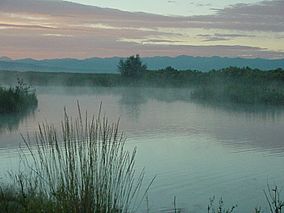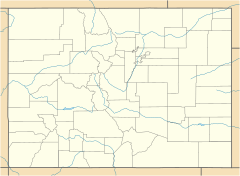Blanca Wetlands facts for kids
Quick facts for kids Blanca Wetlands |
|
|---|---|
 |
|
| Location | San Luis Valley |
| Nearest city | Alamosa, Colorado |
| Area | 10,000 acres (4,000 ha) |
| Established | 1965 |
| Governing body | Bureau of Land Management |
The Blanca Wetlands is a special area in the San Luis Valley of Colorado, United States. It is also known as the Blanca Wildlife Habitat Area. This place is a safe home for many birds, fish, and other animals. You can find it about 11 miles (18 km) northeast of Alamosa.
Long ago, the wetlands were completely destroyed. This happened because people pumped out and moved water for farming. But starting in 1965, the Bureau of Land Management began to bring them back to life. Now, the Blanca Wetlands are a very important natural area. They provide a great home for many different kinds of birds and other wildlife.
Contents
Where are the Blanca Wetlands?
The Blanca Wetlands are in a cool, dry part of Colorado. It gets about 107 days without frost each year. Temperatures can go from very cold, around -30°F (-34°C), to warm, about 85°F (29°C). The area gets only about 7 inches (18 cm) of rain each year.
The land here is mostly flat. You can see sand dunes with a few plants like greasewood and salt grass. Mixed in with the dunes are low areas that used to be wet lakebeds, called playas. In the 1800s, this area was much wetter. Fish bones found here show that some water was at least 12 feet (3.7 m) deep.
However, in the 1900s, the water disappeared. This was due to pumping and moving surface water for irrigation (watering crops). By the mid-1900s, these lakebeds were completely dry. People even called the area "Dry Lakes."
In 1965, the Bureau of Land Management started a project to restore these dry lakebeds. They wanted to turn them back into wetlands. The Blanca Wildlife Habitat Area now covers almost 10,000 acres (4,000 ha). It is south of San Luis Lakes and close to the Great Sand Dunes National Park and Preserve. This area has about 200 shallow basins. These basins have wet meadows, salty flats, marshes, and fresh water ponds. By 1989, about 1,400 acres (570 ha) were ponds and wetlands. More wetlands were planned to be developed.
Plants that grow in these wet areas include bulrush, cattail, and pondweed. Each year, about 1,200 acres (490 ha) are watered. Other parts are allowed to dry out on purpose. This helps the land stay healthy.
How the Wetlands are Managed
The Blanca Wildlife Habitat Area is a special "mitigation site." This means it helps make up for wetlands that were lost. These losses happened because of a project called the Closed Basin Project. This project collects groundwater for irrigation.
The Bureau of Land Management works with many groups to protect and restore the wetlands. Some of these partners include the Colorado Division of Wildlife and the United States Fish and Wildlife Service. They also work with Ducks Unlimited and others.
The wetlands are known as an Area of Critical Environmental Concern. This means they are very important for nature. To protect nesting birds, the wetlands are closed to visitors from mid-February to mid-July. At other times, people can visit for fishing, hunting waterfowl (like ducks), and watching birds.
Amazing Wildlife
The Blanca Wetlands are one of the most important places for birds in Colorado. Many migrating waterbirds and shorebirds stop here. The wetlands are home to 13 species that are threatened, endangered, or sensitive. This means they need special protection.
Birds like the bald eagle and the peregrine falcon use these wetlands. The snowy plover and the white-faced ibis have been seen nesting here. Other important birds include the American bittern, avocet, and greater sandhill crane. Shorebirds like gulls, sandpipers, and pelicans also live in the salty areas. In total, 158 different bird species have been seen here. The wetlands are also a major breeding area for ducks, especially mallards.
The wetlands are also very important for amphibians. There are many Great Plains toads living here. Other amphibians include the plains spadefoot toad, western chorus frog, and tiger salamander. Several types of bats also live in the wetlands.
You might also spot small mammals like the least chipmunk and the Ord's kangaroo rat. Larger animals like muskrats and coyotes are present. You can often see mule deer and elk in the wetland area too.
Water for the Wetlands
Some water for the Blanca Wildlife Habitat Area comes from the Closed Basin Project. This project mainly collects groundwater for farming in the Rio Grande valley. The amount of water given to the Blanca Wildlife Habitat Area and the Alamosa National Wildlife Refuge is limited to 5,300 acre-feet (6,500,000 m³) each year. In 2006, the Habitat Area received 950 acre-feet (1,200,000 m³).
The wetlands also get water from over 40 natural wells called artesian wells. To get even more water, the Bureau of Land Management has looked into trading land for water rights. This would help make sure the wetlands have enough water.
The Bureau of Land Management must keep certain "mitigation acres" wet. This helps make up for any negative effects of the Closed Basin Project. In 2010, the Bureau of Land Management looked at plans to dry out parts of the wetlands on a large scale. This might seem strange, but drying is a natural process. It helps plants grow and removes salt from the soil. They also considered watering the nearby South San Luis Lakes. This would help animals move between the wetlands in the state park and the Blanca Wetlands.




